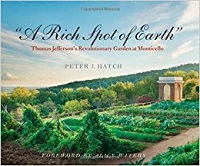
Peter Hatch has been the Director of Gardens and Grounds at Monticello, near Charlottesville, Virginia, since 1977. I find his recently (2012) published “A Rich Spot of Earth” to be the most engaging of the Miller Library’s several books on Thomas Jefferson’s famous home.
Hatch is a skillful writer, blending much of Jefferson’s own words into his narrative. The narrative tells how the former President was enthralled with all matters of gardening, especially of food crops throughout his life, despite his many public duties. He was also deeply involved with the fabric of his local community and region, and seemed to value friendships that did not overlap with his professional career.
Not surprisingly, I found the chapter on gardening books in the presidential library especially interesting. I think all gardeners will find something of value in the discussions on Jefferson’s approaches to garden layout, planting methods, soil amending, staking, seed saving, and dealing with pests and weeds – you’ll easily forget that your mentor lived roughly 200 years ago.
The second half of the book is subtitled “A Catalog of Selected Monticello Vegetables.” Similar to many how-to books on vegetable gardening, this is an evaluation of the many favorite crops grown on the estate, broadly divided by the edible portion of each, including fruits, roots, and leaves. Most of the selections are familiar, but some were used in different ways than we do now, and some the modern reader may find a bit odd.
For example, nasturtiums were grown primarily for their seeds, while the flowers were only a garnish. Jefferson had a passion for sesame (Sesamum indicum), and experimented unsuccessfully with different pressing techniques to produce oil.
Finally, every gardener has his or her favorites, and “Jefferson fussed over his garden asparagus far more than any other vegetable.” It was only grown in “in carefully amended beds because this long-lived perennial…was a major investment.” I think most gardeners can relate to this type of obsession.
Excerpted from the Fall 2016 Arboretum Bulletin.